Nothing bland about this event
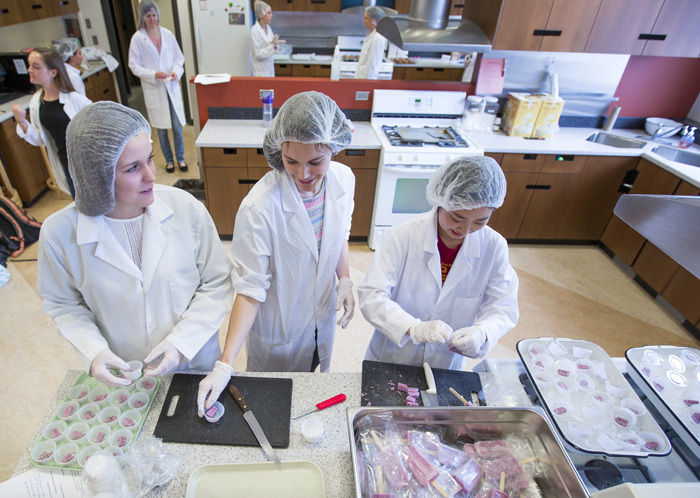
(From left) Brandi Wilkins, Anna Dice and Huahua Ouyang prepare samples of their team's coconut cream/fruit/chia seeds frozen dessert bar prior to the class' new foods showcase in MacKay Hall on Monday. Photo by Christopher Gannon.
Vegetable-mango gazpacho. Crunchy sweet potato cereal. A frozen dessert-on-a-stick containing coconut cream, multiple fruit juices, chia seeds and chocolate chips. Mango snack sticks with a habanero-cashew dip. Such were the offerings at this spring's new foods showcase, hosted May 2 by students in FSHN 412. In teams of three to four, Lester Wilson and Ken Prusa's 41 students developed 11 new food products in less than 15 weeks.
Last week, the teams tested their products with nearly 20 food industry professionals, so Monday's event was a chance to share their efforts with friends and schoolmates. The assignment? Develop a recipe for a new food product, paying attention to what's trending in health and tastes; scale it up to 50 packages' worth and prepare it for commercial distribution, including packaging and pricing.
Culinary science senior Katelyn Decker was part of a trio sharing samples of a soy-based (i.e. protein-packed) lemon and blueberry toaster waffle. Nice work for a team that spent the first nine weeks of the term trying to develop a tofu-derived dry pancake mix. Too much moisture in tofu and too little time left in the semester forced them to reset their sights on a frozen (and delicious) waffle product.
"Tofu is a market trend and fits the vegan lifestyle," Decker explained about their tenacity. "But we hit a lot of 'no, no, no's' this semester, until finally we got our 'yes!'
"It was a very challenging semester, but we definitely learned a lot. And we conquered a lot of obstacles together," she added of her team.
Graduating class is a record-setter
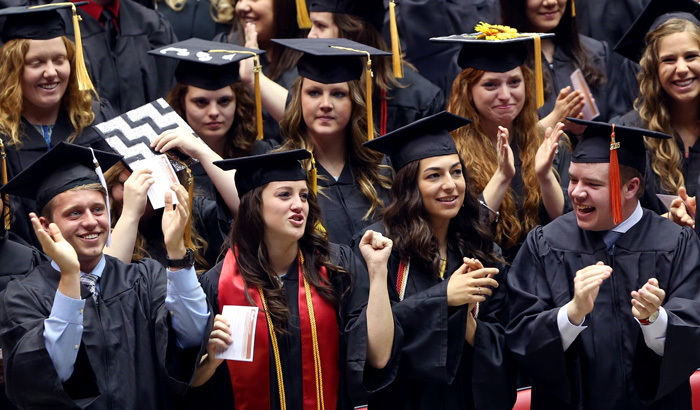
Photo by Christopher Gannon.
Changes being implemented this semester to graduation weekend now include moving the undergraduate ceremony outside to Jack Trice Stadium on Saturday, May 7. President Steven Leath announced the venue change April 29, due in part to several years of record enrollments and corresponding record graduation classes. Iowa State will graduate an anticipated 4,601 students this week, an increase of more than 225 over last spring's largest-ever graduating class.
"It has long been Iowa State's tradition to ensure everyone is welcome to attend the ceremony," Leath wrote in a letter to students, faculty and staff. Noting that a significant stadium renovation was completed last summer, "this will be an exciting venue for our graduates and guests," he wrote.
More info
Schedule of college graduation events
An anticipated 3,823 undergraduates will complete degrees from Iowa State this semester. The undergraduate ceremony will begin at 1:30 p.m.; stadium gates 3 (south) and 5 (northwest) open at 11:30 a.m. and all guests will sit in the west bleachers. If weather threatens the outdoor plans, an announcement will be made by noon Friday to move the ceremony back to Hilton Coliseum. Regardless of the venue, video of the ceremony will be livestreamed in Stephens Auditorium and online from the registrar's website.
U.S. Energy Secretary Ernesto Moniz will give the commencement address. Moniz, a nuclear physicist, has led the federal Department of Energy since May 2013. Previously, he served for 40 years on the physics faculty at the Massachusetts Institute of Technology, Cambridge.
Graduate, veterinary medicine ceremonies
The Graduate College will move its ceremony from Friday to Thursday evening, May 5, as part of the changes this spring. An anticipated 113 doctoral and 523 master's students will be honored. The ceremony begins at 7:30 p.m. in Hilton Coliseum. Dan Nettleton, Distinguished Professor in Liberal Arts and Sciences (statistics) and holder of the Laurence H. Baker Chair in Biological Statistics, was selected to address the graduates. The Algona native has been a member of the ISU faculty since 2000. At any given time, Nettleton is mentoring four to six doctoral students.
Plans to recognize Iowa State's anticipated 142 doctor of veterinary medicine candidates remain largely unchanged from past years. The ceremony will begin at noon Saturday in Stephens Auditorium. Dr. Marcus Kehrli, director of the U.S. Department of Agriculture's National Animal Disease Center in Ames since 2013, will address the graduates. Kehrli holds four Iowa State degrees, including a D.V.M. and a Ph.D. in immunology, and also serves as collaborating faculty member in the animal science department. His research focus is on infectious diseases in cattle and swine.
Changes to graduation weekend
As first announced in January, several changes to commencement weekend are being implemented this semester to improve the experience for families. Other key ones are:
- Graduation traditions – for example, caps and gowns, conferring of degrees or a keynote speaker – that over time had crept into the college events will be reserved for the university-wide ceremonies
- Final exams end at noon on Friday
- Four of the six undergraduate colleges have assigned times in Hilton Coliseum Friday afternoon, evening or Saturday morning for their own events. The other two colleges, Engineering and Design, have developed traditions of hosting smaller events by department or program, and will continue to hold those events in their college spaces.
Tickets are not needed for any graduation events, including a reception hosted by the ISU Alumni Association immediately following the undergraduate ceremony on Saturday afternoon (approximately 4 p.m. in the Alumni Center).
Welcome
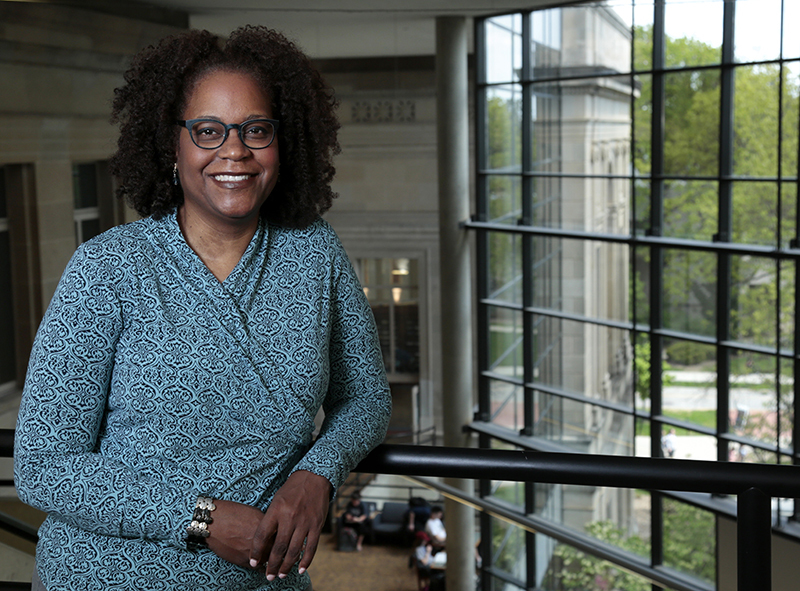
Photo by Christopher Gannon.
Petrina Jackson began her duties as head of special collections and university archives on April 18. Jackson, who earned a master's degree in English from Iowa State in 1994, returns to her alma mater after serving as head of instruction and outreach at the University of Virginia's special collections library since 2008.
Jackson oversees the acquisition, preservation and availability of items in the university library's special collections and archives -- including printed materials, digital files and artifacts. Her office is located in 403 Parks Library. She can be reached by phone (294-8270) and email (pjackson@iastate.edu).
Senate approves clinical faculty titles
The Faculty Senate wrapped up its 2015-16 business at its May 3 meeting by approving new titles for nontenure-eligible (NTE) posts. The appointments -- clinical professor, clinical associate professor and clinical assistant professor -- are expected to be used primarily in the College of Veterinary Medicine.
"This proposal was generated by the vet college a number of years ago," said Martha Selby, chair of the senate's governance council. "Most of the vet colleges -- approximately 80 percent -- across the country have these titles. It just better recognizes the positions and jobs they do."
The proposal outlined the need to:
- Recognize the diverse, demanding and complex contributions of Vet Med faculty
- Increase the number of clinical and diagnostic specialists who teach and serve
- Recruit, recognize and retain veterinary clinical and diagnostic experts
Implementation begins in January 2017. The clinical professorships would have the following renewable terms:
- Clinical assistant professor: 1-3 years
- Clinical associate professor: 3-5 years
- Clinical professor: 3-5 years
In addition, assistant and associate professors could be considered for promotion after five years.
The clinical titles will not be limited to Vet Med faculty. Selby said a process will be developed for current clinicians and senior clinicians to apply for clinical professorships, where appropriate.
Promotion and tenure
Senior vice president and provost Jonathan Wickert presented the annual promotion and tenure report, with a breakdown of the 62 cases reviewed this year. He said five additional cases were not forwarded for institutional review.
"We've tried to put in place -- and be successful at having -- a culture that really focuses on recruiting very good faculty, mentoring them, providing professional development opportunities and doing everything we can to make the promotion and tenure process and standards clear, and -- as it comes to this point in the cycle -- being able to celebrate the success that we've had," Wickert said.
Of the 62 P&T cases under review, 31 tenured faculty were granted promotion to professor, 28 were promoted to associate professor with tenure and three were not approved.
Demographically, the three unsuccessful cases were male candidates -- one white/Caucasian and two Asian-Americans. Among underrepresented groups, the 59 successful P&T cases included three black/African-Americans (all male); 14 Asian-Americans (eight men, six women); and one Latino. The 41 successful white/Caucasian candidates included 24 men and 17 women.
Wickert said this year's P&T cohort was smaller due to the recession. The FY10 hiring cycle included just 44 faculty hires -- 14 already with tenure and 30 who were tenure-eligible. Nine of the 30 in that cohort left the university without tenure, nine more were granted tenure clock extensions and 12 received tenure.
Wickert also shared some of the factors that help successful P&T cases, including:
- Partner accommodations (237 dual career couples since 2011; 73 percent retention rate)
- Tenure clock extensions (189 granted since 2003; 37 percent tenured, 34 percent pending cases)
- Equity advisers in each college
- Orientation and career advancement/development programming
- Mentoring
Cyclone marching band represents US in D-Day commemoration
Iowa State University Cyclone Football "Varsity" Marching Band director Steven Smyth said he would never take a band overseas.
"It would be a logistical nightmare," he said.
But a personal invitation by the United States government to perform at the 72nd commemoration of World War II's D-Day invasion of Normandy, France, was too hard to pass up. So on June 2, 168 marching band members, 40 parents and alumni, 14 sousaphones, 14 percussion instruments and dozens of other brass and woodwind instruments, will board two planes to France. They will return June 9.
"We were invited because of the strength of our program," Smyth said. He added that university bands from Ohio State and Texas have participated in past commemorations.
A brief history lesson
D-Day occurred June 6, 1944, when approximately 156,000 American, British and Canadian Allied troops landed on five beaches along a 50-mile stretch of France's Normandy region, a German stronghold. By late August 1944, northern France had been liberated. Historians consider this event the beginning of the war's end.
Each year since, the U.S. military holds a commemoration honoring America's World War II veterans and the soldiers who lost their lives during the battle. Roughly 30,000 to 40,000 people attend the French event annually.
ISU representing the USA
The Cyclone marching band will perform several times during the trip, including memorial services at the Normandy American Cemetery at Omaha Beach and the Brittany American Cemetery. The band also will perform twice in the village of St. Mere Eglise -- at the town square and in the D-Day Memorial Parade. A final performance near the Eiffel Tower in Paris will wrap up the week.
The musical selections for these concerts are understandably more solemn than normal. Smyth said the U.S. military chose the songs, which include "Amazing Grace," "America the Beautiful," "The Longest Day March" and "The Star Spangled Banner."
The students will leave their Cyclone uniforms at home, instead donning dark slacks and gray pullovers emblazoned with the American flag and a small Iowa State logo.
"We are representing America as much as Iowa State," Smyth said.
Fundraising
The trip costs $3,400 per student, which covers airfare, hotels and meals. Organized fundraisers, like bean bag tournaments, helped students offset some of those costs. A FundISU campaign this spring raised almost $44,000, which primarily covers transportation costs for the students and their instruments.
Sightseeing opportunities
The weeklong trip will afford some time to sightsee, especially historical locations. That, Smyth said, was a factor in his decision to pursue this trip.
"I would never have taken a band overseas, but it's not often we can see a really important part of American history," he said. "We've had outreach with veterans [to prepare for the trip], and so a lot of this has been educational. That's been fun."
No mad dash toward digital-only course materials
Most Iowa State faculty believe digital course materials generally cost less. But few think digital materials are of higher quality than print materials or that students prefer digital over print.
Complete survey results (PDF)
Few faculty currently use course materials that are primarily digital. However, five years hence, the majority of instructors expect their materials will be mostly digital.
When selecting course materials, Iowa State faculty pay the most attention to their own assessments and costs to students.
These are among findings from a course materials survey conducted for the Independent College Bookstore Association last fall and winter. The survey of approximately 3,000 faculty at 29 institutions includes responses from 136 ISU faculty.
University Bookstore manager Heather Dean noted that ISU survey results were similar to the combined results for all participating universities and colleges. Her take on the results?
"The printed book is not going away and digital is not a one-size-fits-all model," Dean said. "It all has to be catered to the developed curriculum of the class. At the bookstore, we continue to make course material affordability for students a top priority while faculty continue to focus on content quality.
"With the evolution of textbook rental, used book marketplace and digital offerings, we've been able to decrease overall costs of textbooks to students by $120 per semester since 2009. In fall 2015, we saved students more than $1.7 million on course materials."
Following are a few samples showing ISU responses to the survey.
Digital course views
|
(% who agree) |
|
|
Digital course materials generally cost less for my students |
75.8 |
|
Digital course materials are preferred by my students over print |
18.0 |
|
Digital course materials are as easy for me to use as similar print materials |
42.9 |
|
Digital course materials have a beneficial impact on student learning compared to print |
47.5 |
|
Digital course materials are higher quality than similar print materials |
28.2 |
Important factors in selecting textbooks and course materials
|
(% indicating factor is important) |
|
|
My own assessment |
97.8 |
|
Cost for my students |
87.4 |
|
Comments from students or teaching assistants |
75.4 |
|
Comments from colleagues |
74.1 |
|
Available supplemental resources for students |
40.3 |
|
Supplemental instructor materials |
39.3 |
|
Available access to unlock digital supplements |
26.1 |
How soon before your course materials will be primarily digital?
|
% |
|
|
Currently (fall 2015) |
16.9 |
|
Next year (fall 2016) |
3.1 |
|
3 years (fall 2018) |
25.4 |
|
5 years (fall 2020) |
22.3 |
|
7 Years (fall 2022) |
9.2 |
|
Never |
23.1 |
University Bookstore staff were part of the survey task force that included staff from several other universities. University Bookstore is owned and operated by Iowa State.
Stories by students
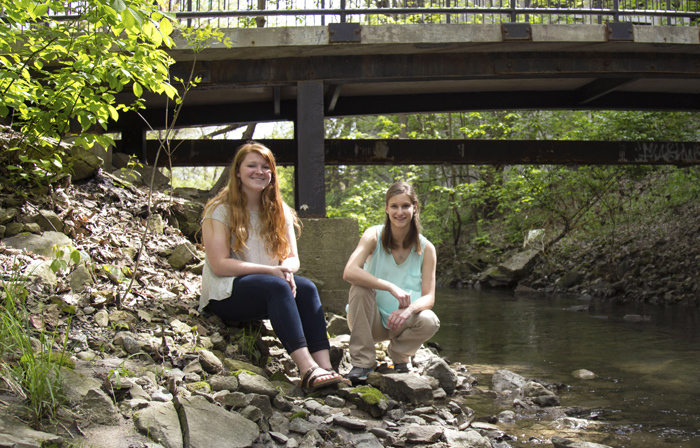
Student writers Megan Gilbert (left) and Kelsey Faivre. Photo by Matt Wettengel.
This spring, Inside Iowa State received an opportunity to publish students' work from a science journalism course, JLMC 347. Assistant professor Dara Wald asked her students to pursue assignments in both the social sciences and physical or life sciences/engineering.
Included in this issue of Inside are two stories Wald selected from the latter category:
- "Algae: A possible source of biofuel for Iowa," by Kelsey Faivre, senior in agricultural and life sciences education
- "Skin-like technology helps detect fractures in bridges," by Megan Gilbert, junior in journalism and mass communication
Skin-like technology helps detect fractures in bridges
A Minneapolis highway bridge collapsed in 2007 during an afternoon rush hour, killing 13 people and leaving 145 injured. Assistant professor of civil, construction and environmental engineering Simon Laflamme says that today's technology, had it been available then and installed in the correct location, could have detected a local anomaly and closed the bridge, potentially avoiding the disaster.
Laflamme is working with the Iowa Department of Transportation (IDOT) to develop skin-like sensors to monitor steel girder supports and ensure the safety of bridges in Iowa.
"We want to detect a fracture before it becomes a big problem," Laflamme said.
Stress fractures are small cracks in the support beams of a structure. They can result from repeated heavy traffic or natural processes.
"Cracks are very dangerous, and being able to detect them is very hard, but the skin would be able to do that," Laflamme said.
This skin is a flexible ethylene-butylene-styrene material, similar to what is used in some medical prostheses, and analogous to human skin.
"The skin is a flexible electronic," Laflamme said. "It gives a signal, and that signal depends on its geometry. If there's a change in geometry, for example from a crack, the signal will change."
Current detection
Bridges and other complex structures are examined by visual inspection or methods of non-destruction evaluations such as thermography and acoustic emission -- approaches that are expensive.
Laflamme's relatively inexpensive electronic skin technology would constantly update data from a monitored structure to a computer system. The system operator would receive notification if there were a significant change that triggers a reaction.
Because the skin can detect a fracture as small as 0.254 mm wide -- one-fifth of the thickness of a penny -- engineers can close bridges and investigate the damage before a crack leads to something more serious.
"The skin gathers data on large areas of interest. We can look at the data to try to predict danger," he said. "It could save lives."
Aging inventory
Many of Iowa's steel girder bridges have been in service for more than 30 years and are beginning to show signs of fatigue, according to IDOT.
The department has tried various procedures to monitor and prevent cracks, but none of their efforts have proven to be cost-effective. To ensure the safety of bridges, routine inspections are carried out to determine physical and functional conditions and observe any changes.
Laflamme said that, while the skin is not a solution to every problem a bridge may have, it still could help monitor the condition of support beams and ultimately protect drivers. He noted that the skin technology can't predict fractures, but he's hopeful the technology might advance to that point.
His research has attracted national attention and is being tested by a pool of other states.
"There are other people who do skin-type sensors, but this is one of the first that can be done on a large scale, at a low cost," Laflamme said. "It's a big step forward in the field of structural health monitoring."
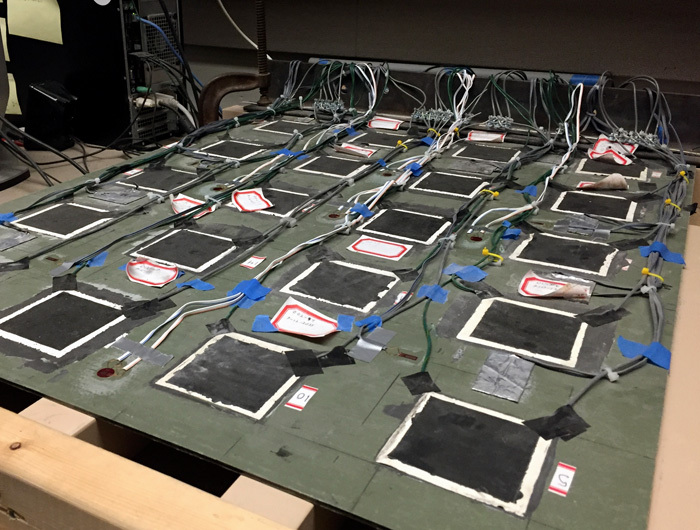
These skins are being tested in Iowa State labs to determine their efficiency and accuracy. Tests simulate deformations of a structural component and analyze the response that sensors recognize as changes in the geometry of the structure. Photo by Megan Gilbert.
Algae: A possible source of biofuel for Iowa
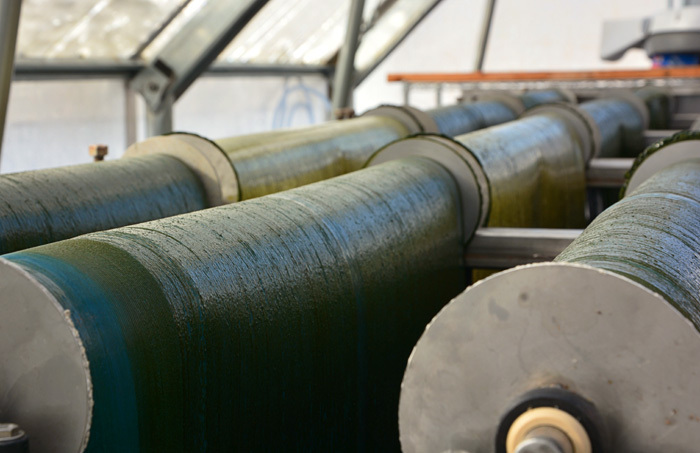
At ISU's BioCentury Research Farm, researchers developed a biofilm-based revolving algal biofuel system, which dips algae in water but allows it to grow vertically and remain concentrated for easy harvest. This allows up to 10 times the productivity in the same footprint while removing 30 percent of the cost of traditional tank-based harvesting. Photo by Kelsey Faivre.
A rising star in the world of biofuels has the potential to not only fuel trucks, but also clean water, feed livestock and fertilize crops. Algae, a microorganism that usually is considered a nuisance, is gaining ground and redeeming itself as a source of fuel for the future.
In a state where water quality concerns are high, algae grows on farm ponds, takes over Lake LaVerne in the summertime and has become a huge concern for the Gulf of Mexico. According to a study published in Ecological Engineering, algae produce toxins that can be harmful to human and animal health and result in serious ecological damage. However, when used to treat wastewater, algae can help prevent too many nutrients, such as nitrogen and phosphorus, from getting into bodies of water and causing harmful algal blooms.
In order to grow, algae need a liquid environment that is high in nitrogen and phosphorus. Wastewater from municipalities satisfies these requirements. As the algae grow, they consume the nitrogen and phosphorus along with carbon dioxide from the atmosphere. Along the way, they release oxygen into the air.
Efficient fuel option
Algae can be harvested and processed into a liquid biofuel, or a fuel that is derived directly from plant matter. According to a study published in Energy Policy, algae have the potential to be a more sustainable fuel option than corn, fossil fuels or grasses. Similar to a corn kernel used for ethanol, only part of the algae is needed to produce fuel. The remaining biomass can serve other purposes.
"It's a good story. You grow algae on the wastewater, [then] take the nitrogen and phosphorus out of the wastewater. Now that nitrogen and phosphorus are in the algae biomass, you actually can apply that to the soil. It's a cycle," said Martin Gross, postdoctoral researcher in food science and human nutrition and facility manager for ISU's BioCentury Research Farm.
Harvesting, processing are problematic
Gross, whose research primarily has centered around finding the best way to harvest algae, said they can play an important role in the future of biofuels, though perhaps not as a competitor to existing biofuels. He said the push for biofuels is strong, and algae biofuels can coexist with corn ethanol and soybean biodiesel, two of the most common biofuels used today.
There are some limitations to the production and processing of algae into biofuels. Even with new innovations, such as biofilm for easy growth and harvest of algae developed at Iowa State, it is hard to make the economics work in favor of algae. Low fuel prices and low agriculture commodity prices, Gross said, are not good for the biofuel industry. It's tough to produce a gallon of algae biofuel that is inexpensive enough to compete in the market, especially with some of the inherent challenges of processing algae.
"The downside is that it's wet," Gross said, laughing.
The vast majority of biofuel processing facilities have been developed for dry feedstock -- materials such as corn and soybeans. This requires algae to be dried down before it can be processed using existing methods, which adds to expenses.
There are some new algae technologies on the horizon. Algenol is a Florida-based company working to genetically engineer cyanobacteria, a microalgae, to produce and secrete ethanol as it grows. Gross said this is promising technology, but faces challenges moving forward because even common genetically engineered, easily traced crops like corn face a tough regulatory environment. There are concerns about how a microorganism like cyanobacteria will stay contained and prevented from entering the wild, according to Gross.
New processes are being developed for the growth, harvest and processing of the microorganism that could change its place in the biofuels arena. For Iowans, this could have an impact not only on the price of fuels, but also the quality of the water released into lakes and rivers from municipalities. That could equate to a state that has algae growing to its benefit instead of its detriment.
